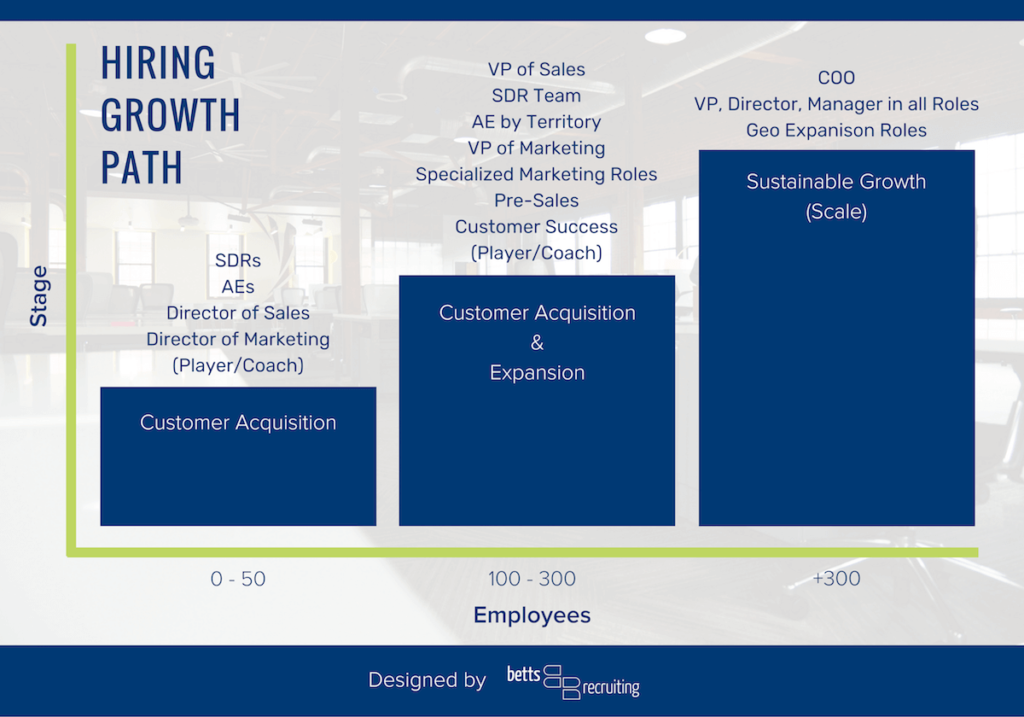The ultimate goal, for almost any growing business, is to reach the sweet spot – that coveted level of unrestrained success known as sustainable growth, which tends to occur at about 300 employees and/or roughly $100M in annual revenue (see infographic below).
No sweat, right? Well, before you start envisioning those cliff-diving vacays with future buddy Richard Branson, there is a tremendous amount to consider on the way to the top.
While models may vary slightly from company to company, Betts has recognized five common stages of scaling that your organization can expect to encounter on the way to sustainable growth:
The First 10-50 Sales People
A healthy $$ start from an optimistic board marks the beginning of your company’s journey. During this initial phase (highlighted in stage one of our infographic), you’ll primarily rely on your brand’s overall concept and tone to reel in the first 10 or so characters with diverse backgrounds, not just sales. They are your “missionaries,” they’re non-traditional, and they love to spread the company message. Because they’re the OGs of your crew – who believed in you when others didn’t – they get first dibs on a ride up the ladder when the time is right (right?). Their excitement and drive are vital in hiring the next 30-40 employees, money-hungry “mercenaries” that will give your brand the first inkling of expertise and management potential.
The Leap to 100
No turning back now. As you look to make your way to 100 employees, where upper-level management roles become more and more vital, the desire to grow quickly should not overshadow the need for a stable bottom line. Wait. Assess. It’s a dark art. Don’t get too cocky and rely on outdated revenue models that are still overly rampant in business. Typically, a VP of sales is told, “Here’s the revenue plan. Go execute.” But if the assumptions are wrong, you’ll get destroyed. Sales heads on the front lines of your business need to be a significant part of the process and help you avoid any potential pitfalls. Keeping your head in the game 24/7 and staying as close to the numbers as possible is key. (It was nice having a life, wasn’t it?)
Stage Three: Spreading Out Responsibility
Stretching beyond 100 employees is no small challenge. Unless you immediately outfit your org chart with VPs (sales and marketing), regional directors, customer success supervisors, etc., it will become more difficult to grow your brand to the next level while overseeing your existing lineup of dedicated workers. So if you don’t enjoy multi-tasking in a wind tunnel, you’ll need to get those expert professionals in charge of your massive team. You’ll need proven leaders who can take the worry off your plate and keep the wind at your back (see the second stage of the infographic).
200 Employees: Expansion Takes Hold
The ability to expand grows larger as you approach 200 employees. It’s an exciting time for any company, and real success now depends on a much more extensive team that can maintain (or surpass) customer retention goals and sales conversion rates. This is where the more niche positions come into play, such as specialized marketing roles and pre-sales roles that can help keep you directly connected to your audience as you grow. But look out! It doesn’t matter how big you are — if you lose the human touch that got you to this point, your entire plan could crumble.
The Final Stage: $100M
As you lean back to make your final slide into a 300-plus employee (see the last stage of our info-graphic), which usually looks something like a $100M business, it’s time to confirm a complete C-suite of dedicated execs (CFO, CMO, CIO, CEOs, etc.), a full lineup of managers and directors from top to bottom, and even geographical expansion roles if you are looking to grow beyond U.S. markets. Have a hypothesis and test them out. Get 1000 customers on the board and A/B test EVERYTHING, because then you’ll really know what will continue to scale. The top team is an extension of you, and should be trusted to supervise the whole shebang in your stead. Finally, your very competent COO is now most likely running the show, so you may keep your mind on the bigger picture, and off that pesky bottom line (if you can).



